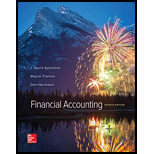
Financial Accounting
4th Edition
ISBN: 9781259307959
Author: J. David Spiceland, Wayne M Thomas, Don Herrmann
Publisher: McGraw-Hill Education
expand_more
expand_more
format_list_bulleted
Concept explainers
Textbook Question
Chapter 1, Problem 1.5BE
For each transaction, indicate whether each account would be classified in the
Assign account classifications (LO1–2)
| Account Classifications | Accounts | Related Transactions |
| 1. _____ | Rent expense | Cost of rent. |
| 2. _____ | Interest revenue | Interest earned on savings account. |
| 3. _____ | Dividends | Cash payments to stockholders. |
| 4. _____ | Land | Land used for operations. |
| 5. _____ | Accounts payable | Amounts owed to suppliers. |
Expert Solution & Answer
Want to see the full answer?
Check out a sample textbook solution
Students have asked these similar questions
Can you help me with General accounting question?
Can you show me the correct approach to solve this financial accounting problem using suitable standards?
I am searching for the accurate solution to this financial accounting problem with the right approach.
Chapter 1 Solutions
Financial Accounting
Ch. 1 - Explain what it means to say that an accounting...Ch. 1 - Identify some of the people interested in making...Ch. 1 - What is the basic difference between financial...Ch. 1 - What are the two primary functions of financial...Ch. 1 - What are line three basic business activities that...Ch. 1 - Prob. 6RQCh. 1 - What are a few of the typical investing activities...Ch. 1 - Prob. 8RQCh. 1 - Prob. 9RQCh. 1 - Provide the basic definition for each of the...
Ch. 1 - Prob. 11RQCh. 1 - What are the four primary financial statements?...Ch. 1 - What does it mean to say that the income...Ch. 1 - Prob. 14RQCh. 1 - What is the accounting equation? Which financial...Ch. 1 - Prob. 16RQCh. 1 - The retained earnings account is a link between...Ch. 1 - Prob. 18RQCh. 1 - Prob. 19RQCh. 1 - Prob. 20RQCh. 1 - Prob. 21RQCh. 1 - Prob. 22RQCh. 1 - Prob. 23RQCh. 1 - Prob. 24RQCh. 1 - Prob. 25RQCh. 1 - What are the three primary objectives of financial...Ch. 1 - Prob. 27RQCh. 1 - Prob. 28RQCh. 1 - Prob. 29RQCh. 1 - What is meant by the term cost effectiveness in...Ch. 1 - Prob. 31RQCh. 1 - Prob. 1.1BECh. 1 - Match each business activity with its description....Ch. 1 - Prob. 1.3BECh. 1 - Match each account type with its description....Ch. 1 - For each transaction, indicate whether each...Ch. 1 - For each transaction, indicate whether each...Ch. 1 - Describe each financial statement (LO13) Match...Ch. 1 - Determine the location of items in financial...Ch. 1 - Prob. 1.9BECh. 1 - Indicate which of the following are objectives of...Ch. 1 - Prob. 1.11BECh. 1 - Prob. 1.12BECh. 1 - Prob. 1.13BECh. 1 - The following provides a list of transactions and...Ch. 1 - Falcon Incorporated has the following transactions...Ch. 1 - Prob. 1.3ECh. 1 - Eagle Corp. operates magnetic resonance imaging...Ch. 1 - Prob. 1.5ECh. 1 - Below are the account balances for Cowboy Law Firm...Ch. 1 - At the beginning of the year (January 1), Buffalo...Ch. 1 - Wolfpack Construction has the following account...Ch. 1 - Tiger Trade has the following cash transactions...Ch. 1 - Prob. 1.10ECh. 1 - At the beginning of 2018, Artichoke Academy...Ch. 1 - Squirrel Tree Services reports the following...Ch. 1 - Prob. 1.13ECh. 1 - During its first five years of operations, Red...Ch. 1 - Below are approximate amounts related to retained...Ch. 1 - Below are approximate amounts related to balance...Ch. 1 - Below are approximate amounts related to cash flow...Ch. 1 - Prob. 1.18ECh. 1 - Prob. 1.19ECh. 1 - Prob. 1.20ECh. 1 - A Below are typical transactions for...Ch. 1 - Account classifications include assets,...Ch. 1 - Longhorn Corporation provides low-cost food...Ch. 1 - Below are-incomplete financial statements for...Ch. 1 - Cornhusker Company provides the following...Ch. 1 - Prob. 1.6APCh. 1 - Listed below are nine terms and definitions...Ch. 1 - Below are typical transactions for Caterpillar...Ch. 1 - Prob. 1.2BPCh. 1 - Prob. 1.3BPCh. 1 - Prob. 1.4BPCh. 1 - Tar Heel Corporation provides the following...Ch. 1 - Prob. 1.6BPCh. 1 - Prob. 1.7BPCh. 1 - Great Adventures (The Great Adventures problem...Ch. 1 - Financial Analysis American Eagle Outfitters, Inc....Ch. 1 - The Buckle, Inc. Financial Analysis Financial...Ch. 1 - Prob. 1.4APCACh. 1 - Prob. 1.5APECh. 1 - Prob. 1.7APWC
Knowledge Booster
Learn more about
Need a deep-dive on the concept behind this application? Look no further. Learn more about this topic, accounting and related others by exploring similar questions and additional content below.Similar questions
- Please provide the correct answer to this financial accounting problem using valid calculations.arrow_forwardCan you demonstrate the accurate method for solving this financial accounting question?arrow_forwardCan you solve this financial accounting problem using appropriate financial principles?arrow_forward
- Hii teacher please provide for Financial accounting question answer do fastarrow_forwardFinancial accountingarrow_forwardHow can the results from the accounts receivable visualizations be used to estimate bad debts expense and allowance for doubtful accounts? Using the Top 5 Customers by Accounts Receivable Amount Due visualization, which customer has the lowest allowance for doubtful accounts value?arrow_forward
arrow_back_ios
SEE MORE QUESTIONS
arrow_forward_ios
Recommended textbooks for you
 College Accounting, Chapters 1-27AccountingISBN:9781337794756Author:HEINTZ, James A.Publisher:Cengage Learning,Principles of Accounting Volume 1AccountingISBN:9781947172685Author:OpenStaxPublisher:OpenStax College
College Accounting, Chapters 1-27AccountingISBN:9781337794756Author:HEINTZ, James A.Publisher:Cengage Learning,Principles of Accounting Volume 1AccountingISBN:9781947172685Author:OpenStaxPublisher:OpenStax College College Accounting (Book Only): A Career ApproachAccountingISBN:9781305084087Author:Cathy J. ScottPublisher:Cengage Learning
College Accounting (Book Only): A Career ApproachAccountingISBN:9781305084087Author:Cathy J. ScottPublisher:Cengage Learning College Accounting (Book Only): A Career ApproachAccountingISBN:9781337280570Author:Scott, Cathy J.Publisher:South-Western College Pub
College Accounting (Book Only): A Career ApproachAccountingISBN:9781337280570Author:Scott, Cathy J.Publisher:South-Western College Pub

College Accounting, Chapters 1-27
Accounting
ISBN:9781337794756
Author:HEINTZ, James A.
Publisher:Cengage Learning,

Principles of Accounting Volume 1
Accounting
ISBN:9781947172685
Author:OpenStax
Publisher:OpenStax College

College Accounting (Book Only): A Career Approach
Accounting
ISBN:9781305084087
Author:Cathy J. Scott
Publisher:Cengage Learning

College Accounting (Book Only): A Career Approach
Accounting
ISBN:9781337280570
Author:Scott, Cathy J.
Publisher:South-Western College Pub
The ACCOUNTING EQUATION For BEGINNERS; Author: Accounting Stuff;https://www.youtube.com/watch?v=56xscQ4viWE;License: Standard Youtube License